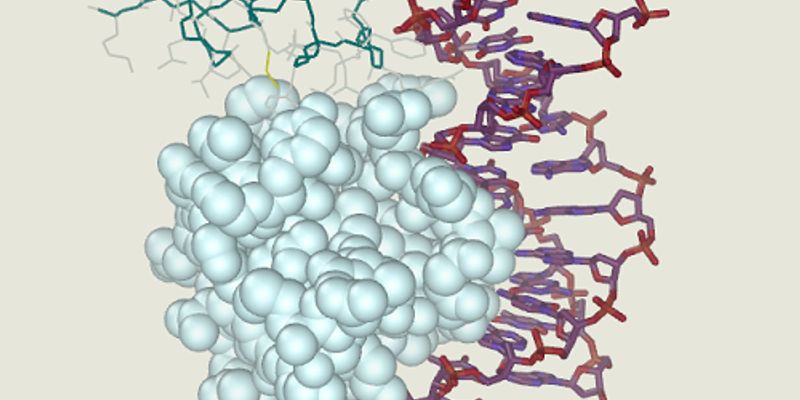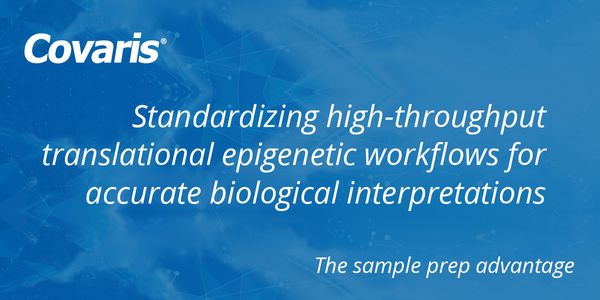DNA-Binding Proteins
DNA Binding Proteins: DNA-binding proteins are proteins composed of DNA-binding domains and thus have a specific or general affinity for either single or double stranded DNA. Sequence-specific DNA-binding proteins generally interact with the major groove of B-DNA, because it exposes more functional groups that identify a base pair..
-
OCT 03, 2018 | 9:00 AMThe most recently developed genome editing system, CRISPR-Cas9 has greater inherent flexibility than prior programmable nuclease platforms. Because of its simplicity and efficacy, this techno...SEP 27, 2018 | 8:00 AMDATE: September 27, 2018TIME: 8:00AM PDTRecent advances in phage display for molecular evolution incorporate deep sequencing to enable greater library coverage. However, severe gap...SEP 27, 2018 | 7:30 AMCellular processes are orchestrated by a large number of biomolecules in a spatially and temporally coordinated manner within a tiny volume. To uncover the underlying organizational principle...SEP 26, 2018 | 12:00 PMWith the advent of cost-effective culturing approaches, 3D cell culture models (3D-CCMs) have been rapidly adopted for drug discovery since they provide a more physiologically relevant micro-...MAY 03, 2018 | 11:00 AMDATE: May 3, 2018TIME: 11:00AM PDT, 2:00PM EDTWhile stress is one of the leading causes of neuropsychiatric disorders, the molecular underpinnings of how stress induces alterations in b...APR 12, 2018 | 9:00 AMThe Whiteson lab uses culture-independent metagenomics, metabolomics, and ecological statistics along with hypothesis driven, reductionist microbiology to answer questions about how bacteria...MAR 27, 2018 | 9:00 AMDATE: March 27, 2018TIME: 09:00am PDT, 12:00pm EDTThe rapid adoption and ease of use of CRISPR-Cas9 has driven the development of applications for gene knockout, precise gene editing, a...SEP 28, 2017 | 1:30 PMThe Resource Identification Initiative supports NIH's new guidelines for Rigor and Transparency as these apply in biomedical publications. Authors are instructed to authenticate key biolo...SEP 28, 2017 | 12:00 PMHow are your RNA yields? Some sample types present special challenges in RNA purification and analysis. In this webinar, we will discuss and provide tips for the following topics: &b...SEP 28, 2017 | 10:30 AMStem cells can self-renew and differentiate into multiple different cell types. Engineering of stem cells has enabled new methods to study development and organogenesis in humans as well as d...SEP 28, 2017 | 9:00 AMContractile non-muscle cells, including smooth muscle and myoepithelial cells, provide the mechanical forces required for tissue homeostasis in numerous organ systems. For example, smooth mus...SEP 28, 2017 | 7:30 AMI will present my lab’s effort on studying and manipulating RNA processing, with particular emphasis on using CRISPR/Cas systems for targeting RNA in living cells in diseases such as my...SEP 28, 2017 | 6:00 AMThe Mexican axolotl (Ambystoma mexicanum) is an aquatic salamander that possesses some of the most astonishing regenerative abilities found in nature. Able to fully regenerate amputated...SEP 27, 2017 | 1:30 PMAlthough the cell is commonly referred to as “the most basic unit of life”, it is actually so complex that despite over 350 years of research we are still far from fully understan...SEP 27, 2017 | 12:00 PMThe manipulation of the genome to study disease, evaluate drug targets and to stratify patient populations is now a widely accepted concept in the field. At Horizon Discovery, genome engineer...Speaker: Danielle FolkardSEP 27, 2017 | 9:00 AMActin cytoskeleton drives cell migration in muscle and non-muscle cells and plays a major role in such diverse processes as tissue morphogenesis, muscle contraction, and cancer metastases. In...SEP 27, 2017 | 7:30 AMEinstein researcher Robert Singer, Ph.D., discusses a breakthrough in microscopy that is allowing scientists to track messenger RNA in living cells in real time. The study, published in the S...SEP 27, 2017 | 6:00 AMA fundamental question in neuronal development is how growth cone cytoskeletal dynamics are coordinated to promote accurate axonal navigation. To address this question, we focus on microtubul...NOV 23, 2016 | 8:00 AMDATE: November 23rd, 2016TIME: 8:00AM PT, 11:00AM ETThe structure of chromatin is critical for many aspects of cellular physiology and is considered to be the primary medium to store ep...SEP 08, 2016 | 10:30 AMThe global trend towards industrialization and urbanization has led to ever more people living and working indoors. Some studies estimate that humans in industrialized countries spend as much...SEP 07, 2016 | 6:00 AMOxford Nanopore’s MinION is a small sensing device which can sequence DNA and RNA directly, without the need to perform an enzymatic synthesis reaction. The device is portable and is po...AUG 30, 2016 | 8:00 AMThe human body is composed of about 200 different cell types. The identity and function of these distinct cell types are precisely programmed by the regulatory networks encoded in the 3 billi...JUN 22, 2016 | 9:00 AMDATE: June 22, 2016 TIME: 9am Pacific time, 12pm Eastern time, 6pm Central European time A large fraction of the RNA transcribed in eukaryotic cells is rapidly degraded in the nucleus. A ...JUN 02, 2016 | 8:00 AMSELEX is a process that selects DNA or RNA from a random library of sequences based on their affinity for a target molecule. These high affinity ligands, called apta...
OCT 03, 2018 | 9:00 AM
The most recently developed genome editing system, CRISPR-Cas9 has greater inherent flexibility than prior programmable nuclease platforms. Because of its simplicity and efficacy, this techno...
SEP 27, 2018 | 8:00 AM
DATE: September 27, 2018TIME: 8:00AM PDTRecent advances in phage display for molecular evolution incorporate deep sequencing to enable greater library coverage. However, severe gap...
SEP 27, 2018 | 7:30 AM
Cellular processes are orchestrated by a large number of biomolecules in a spatially and temporally coordinated manner within a tiny volume. To uncover the underlying organizational principle...
SEP 26, 2018 | 12:00 PM
With the advent of cost-effective culturing approaches, 3D cell culture models (3D-CCMs) have been rapidly adopted for drug discovery since they provide a more physiologically relevant micro-...
MAY 03, 2018 | 11:00 AM
DATE: May 3, 2018TIME: 11:00AM PDT, 2:00PM EDTWhile stress is one of the leading causes of neuropsychiatric disorders, the molecular underpinnings of how stress induces alterations in b...
APR 12, 2018 | 9:00 AM
The Whiteson lab uses culture-independent metagenomics, metabolomics, and ecological statistics along with hypothesis driven, reductionist microbiology to answer questions about how bacteria...
MAR 27, 2018 | 9:00 AM
DATE: March 27, 2018TIME: 09:00am PDT, 12:00pm EDTThe rapid adoption and ease of use of CRISPR-Cas9 has driven the development of applications for gene knockout, precise gene editing, a...
SEP 28, 2017 | 1:30 PM
The Resource Identification Initiative supports NIH's new guidelines for Rigor and Transparency as these apply in biomedical publications. Authors are instructed to authenticate key biolo...
SEP 28, 2017 | 12:00 PM
How are your RNA yields? Some sample types present special challenges in RNA purification and analysis. In this webinar, we will discuss and provide tips for the following topics: &b...
SEP 28, 2017 | 10:30 AM
Stem cells can self-renew and differentiate into multiple different cell types. Engineering of stem cells has enabled new methods to study development and organogenesis in humans as well as d...
SEP 28, 2017 | 9:00 AM
Contractile non-muscle cells, including smooth muscle and myoepithelial cells, provide the mechanical forces required for tissue homeostasis in numerous organ systems. For example, smooth mus...
SEP 28, 2017 | 7:30 AM
I will present my lab’s effort on studying and manipulating RNA processing, with particular emphasis on using CRISPR/Cas systems for targeting RNA in living cells in diseases such as my...
SEP 28, 2017 | 6:00 AM
The Mexican axolotl (Ambystoma mexicanum) is an aquatic salamander that possesses some of the most astonishing regenerative abilities found in nature. Able to fully regenerate amputated...
SEP 27, 2017 | 1:30 PM
Although the cell is commonly referred to as “the most basic unit of life”, it is actually so complex that despite over 350 years of research we are still far from fully understan...
SEP 27, 2017 | 12:00 PM
The manipulation of the genome to study disease, evaluate drug targets and to stratify patient populations is now a widely accepted concept in the field. At Horizon Discovery, genome engineer...
Speaker:
Danielle Folkard
SEP 27, 2017 | 9:00 AM
Actin cytoskeleton drives cell migration in muscle and non-muscle cells and plays a major role in such diverse processes as tissue morphogenesis, muscle contraction, and cancer metastases. In...
SEP 27, 2017 | 7:30 AM
Einstein researcher Robert Singer, Ph.D., discusses a breakthrough in microscopy that is allowing scientists to track messenger RNA in living cells in real time. The study, published in the S...
SEP 27, 2017 | 6:00 AM
A fundamental question in neuronal development is how growth cone cytoskeletal dynamics are coordinated to promote accurate axonal navigation. To address this question, we focus on microtubul...
NOV 23, 2016 | 8:00 AM
DATE: November 23rd, 2016TIME: 8:00AM PT, 11:00AM ETThe structure of chromatin is critical for many aspects of cellular physiology and is considered to be the primary medium to store ep...
SEP 08, 2016 | 10:30 AM
The global trend towards industrialization and urbanization has led to ever more people living and working indoors. Some studies estimate that humans in industrialized countries spend as much...
SEP 07, 2016 | 6:00 AM
Oxford Nanopore’s MinION is a small sensing device which can sequence DNA and RNA directly, without the need to perform an enzymatic synthesis reaction. The device is portable and is po...
AUG 30, 2016 | 8:00 AM
The human body is composed of about 200 different cell types. The identity and function of these distinct cell types are precisely programmed by the regulatory networks encoded in the 3 billi...
JUN 22, 2016 | 9:00 AM
DATE: June 22, 2016
TIME: 9am Pacific time, 12pm Eastern time, 6pm Central European time
A large fraction of the RNA transcribed in eukaryotic cells is rapidly degraded in the nucleus. A ...
JUN 02, 2016 | 8:00 AM
SELEX is a process that selects DNA or RNA from a random library of sequences based on their affinity for a target molecule. These high affinity ligands, called apta...
























